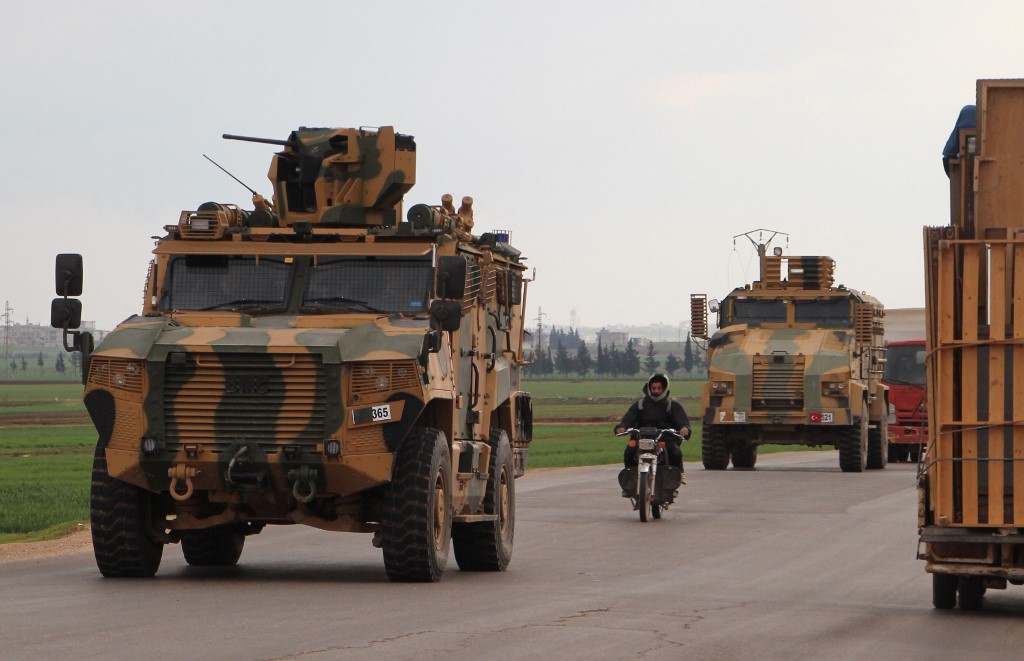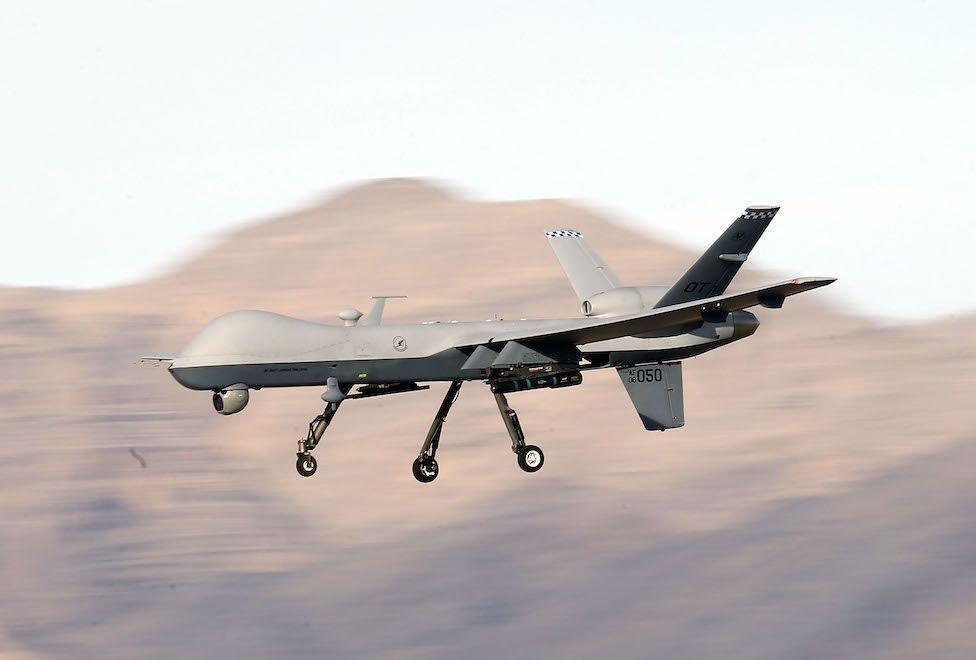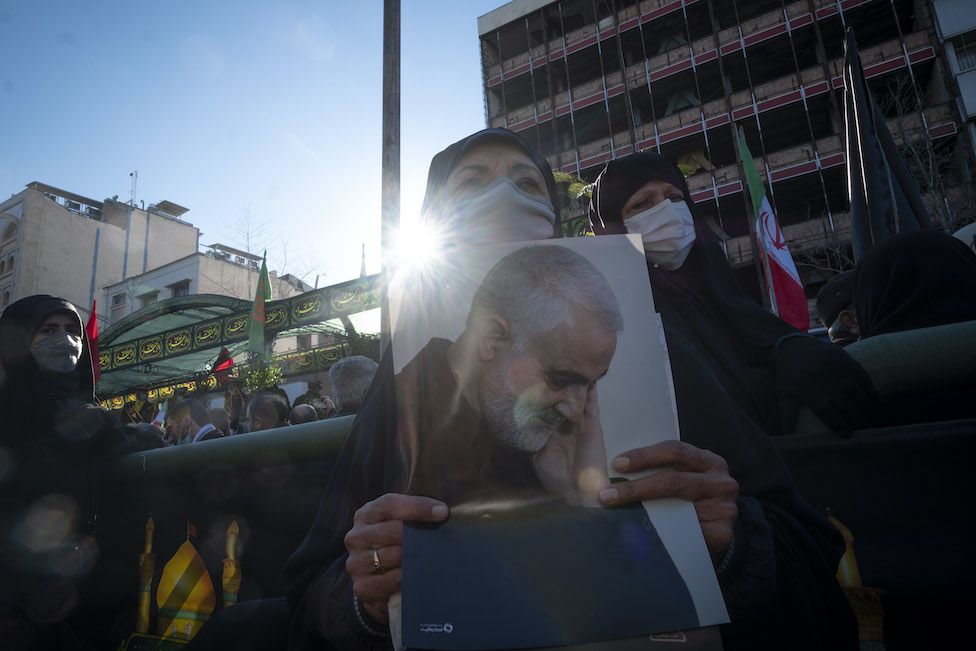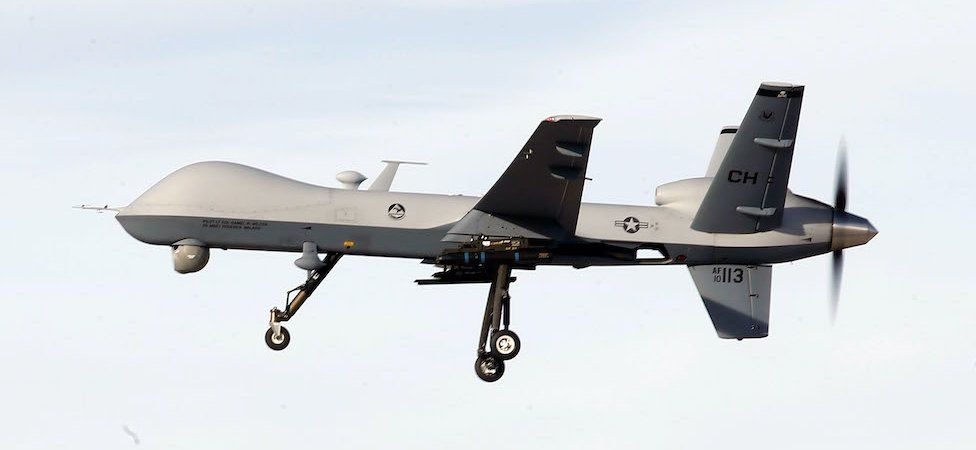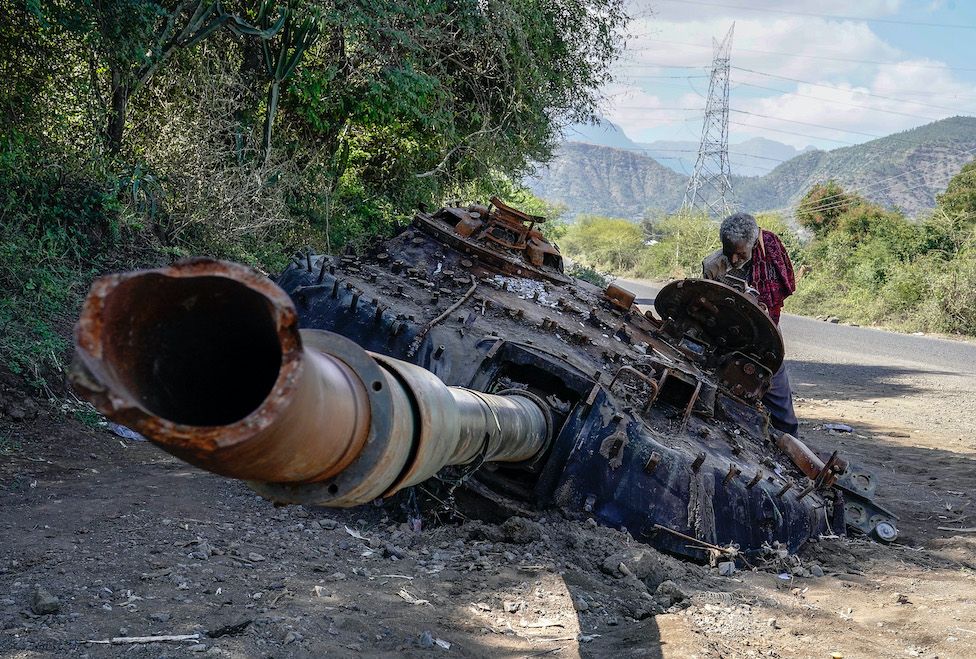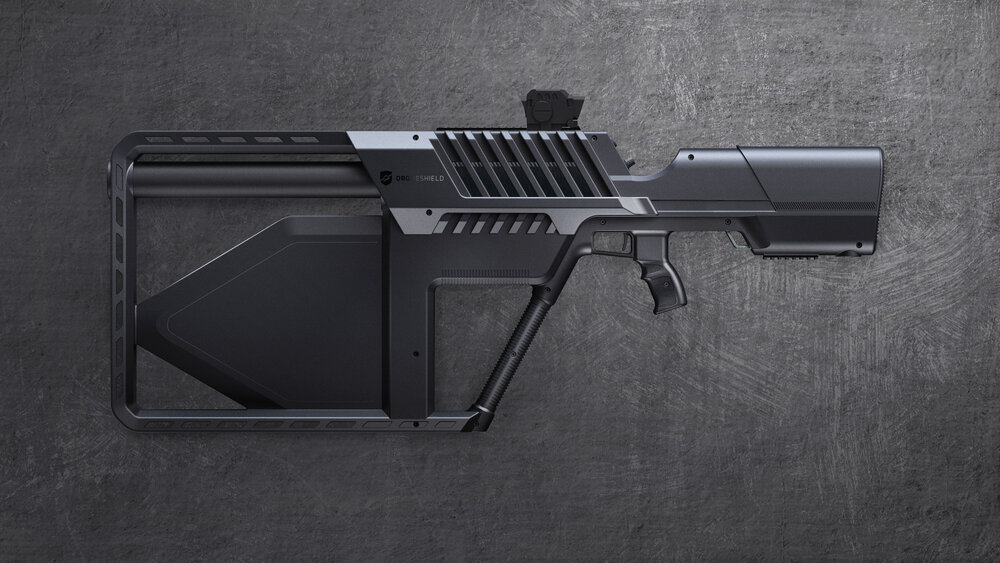
https://theintercept.com/2019/05/14/turkey-second-drone-age/
Finding oneself in the crosshairs of a military drone is, for most people, not the most comforting situation. Yet at an air show last fall, tens of thousands of people had a different reaction.
A military drone took off from a runway, and moments later it began transmitting its view to a giant screen on stage. The video from the drone was clear enough to pick out your own face among the crowd. It was exactly what the drone’s pilot, seated in a trailer not far from the stage, was seeing. The crowd was in the crosshairs, and you could see the data about the aircraft’s pitch, roll, and altitude. In the bottom right corner of the screen, the words “Bore Invalid” indicated the drone was currently unarmed.
It’s the kind of video that, in a war zone, can end with a giant plume of smoke and the tattered remains of whatever the drone has just obliterated. Yet for this crowd, it was like catching a glimpse of themselves on the Jumbotron at a football game. When an announcer shouted out, “We see you, wave your hands!” they erupted in excitement.
The event had all the trappings of a typical air show. Hundreds of thousands of people — from government officials to school children bussed in by the thousands — paraded around the tarmac. They posed for selfies alongside fighter jets and attack helicopters. A team of F-16s flew in close formation, leaving intricate patterns of red and white smoke in their wake. A nearly constant series of sonic booms made it difficult to talk. Massive speakers blared pulsing music.
But there was something different about this air show: It wasn’t in America, the global pioneer of weaponized drones and the customary host of such pageants. It was in Turkey, just outside Istanbul. And the pilotless aircraft that delighted the crowd wasn’t made in America; it was manufactured by Turkey. The crowd was enthusiastic to be in its crosshairs because the spectacle signified that their homeland had taken its place among the most technologically advanced countries in the world.
Their country had entered the second drone age — in which the use of drones to kill people has proliferated far beyond the United States, the first country to kill people with missiles launched from drones after 9/11. Turkey now rivals the U.S. and the U.K. as the world’s most prolific user of killer drones, according to a review by The Intercept of reported lethal drone strikes worldwide. (Other countries that have reportedly killed people with drone-launched weapons include Israel, Iraq, and Iran.) The technology has been used by Turkey against ISIS in Syria and along Turkey’s border with Iraq and Iran, where ever-present Turkish drones have turned the tide in a decades-old counter-insurgency against the Kurdistan Workers’ Party, or PKK.
While the U.S. was the foremost operator of armed, unmanned aerial vehicles (UAVs) in the world for more than a decade, launching the first drone attack in 2001, today more than a dozen countries possess this technology. The U.K., Israel, Pakistan, Saudi Arabia, the UAE, Egypt, Nigeria, and Turkey have all used armed UAVs to kill targets since 2015. Efforts by Washington to control proliferation through restrictions on drone exports have failed to slow down a global race to acquire the technology. Meanwhile, the U.S. has set a precedent of impunity by carrying out hundreds of strikes that have killed civilians over the last decade.
“We are well past the time when the proliferation of armed drones can in any way be controlled,” said Chris Woods, a journalist who has tracked drone use for more than a decade and director of the conflict monitor Airwars. “So many states and even nonstate actors have access to armed drone capabilities — and they are being used across borders and within borders — that we are now clearly within the second drone age, that is, the age of proliferation.”
U.S. exports of armed Predator and Reaper drones are subject to congressional and military oversight, so the process of acquiring them remains long and complicated. Some buyers have opted instead to purchase armed drones from China, which has sold to nearly a dozen countries its CH-4, a drone that has capabilities on par with the Predator (though is less sophisticated than the Reaper). Yet even if major developers like the U.S. or China decide to restrict the sale of armed drones, the genie is out of the bottle — the technology itself can now be replicated. That’s what Turkey has done.
Turkey stands out as not only the most advanced new developer of drones but also as the only country to regularly use them on its own soil, against its own citizens.
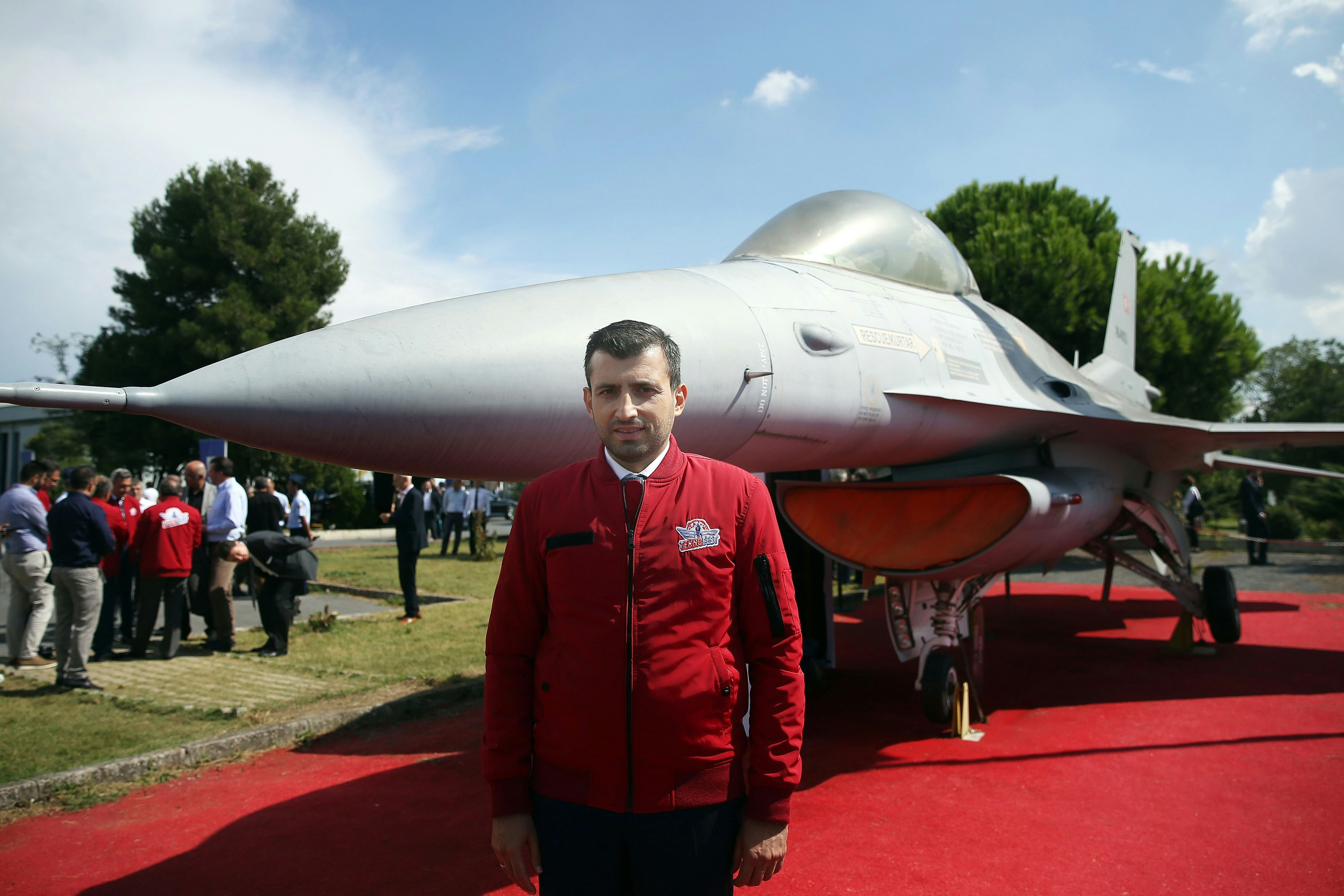
Selcuk Bayraktar at a press event for the TEKNOFEST Istanbul Aviation Space and Technology Festival at the Aviation Museum in Istanbul, Turkey, on Sept. 12, 2018.
Photo: Islam Yakut/Anadolu Agency/Getty Images
Godfather of Drones
If Turkey’s killer drone program can be said to have a godfather, his name is Selçuk Bayraktar.
In 2005, Bayraktar convinced a group of Turkish officials to attend a small demonstration of a homemade drone he had been working on. The 26-year-old had studied electrical engineering at Turkey’s top university, obtained a master’s degree at the University of Pennsylvania, and was a doctoral student at MIT.
He was at the cutting edge of a technology he knew was going to be the next big thing in warfare. But he was worried about what he would do once his studies were over, and it was time to return to Turkey.
“Many of my friends are working on grants for U.S. military projects,” he told the officials standing beside his drone, which he motioned toward. “There’s this incredible thing here —but what will they, what will I work on when I come back to Turkey?”
The officials watched the drone take off on its own. They stood, arms crossed, watching it descend and then gently bounce its way down the landing strip, into the waiting hands of Bayraktar.
“Boeing, Lockheed, these are big companies right?” Bayraktar continued. “We are making those same systems. If Turkey supports this project, these drones, in five years Turkey can be at the forefront of the world, easily.”
It was an audacious pitch, but it didn’t immediately win over the officials. Before that day, Bayraktar was largely unknown among the power brokers in Ankara.
In his graduate studies in the U.S., Bayraktar’s academic colleagues came from around the world. His master’s thesis at MIT demonstrated an algorithm that could land an unmanned helicopter in very rough terrain, even vertically on a wall. The paper’s acknowledgments begin by thanking God, then his adviser, and finally a handful of close friends and the university’s Muslim Students’ Association.
In Turkey, his family owned a firm called Bayraktar Makina, which was started by their engineer father in 1984 to produce automobile components as part of Turkey’s effort to domestically manufacture cars. By the 2000s, the company had begun to focus on unmanned aerial vehicles.
By 2007, Bayraktar had quit his PhD studies at MIT and returned to work on drones full-time in Turkey. It would take a few more years, and a few unexpected twists in international relations, for Bayraktar to find his way to the forefront of Turkey’s killer drone program.
At the time Bayraktar showed off his homemade drone, Turkey already had a drone program, developed by Turkish Aerospace Industries (TAI), the country’s defense manufacturing powerhouse. But bureaucrats in Ankara, especially in the then-powerful military, thought it was wiser to purchase the technology from the U.S. and Israel rather than continue to develop it themselves, despite several decades of disappointments from those allies.
Since 1975, when the U.S. imposed weapons export sanctions after Turkey’s invasion of Cyprus, Turkey had an uneasy relationship with Washington and had sought to develop its own defense industry.
Over the next decade, a slew of domestic defense manufacturers like TAI were established, mostly focusing on basics like ammunition and small arms but also a handful on larger projects like guided missiles and aircraft.
Turkey entered the first drone age the old-fashioned way — it bought six unarmed drones from the U.S. firm General Atomics in 1996. The GNAT 750s it acquired were simple crafts that could deliver a video feed. They were used in Turkey’s Kurdish-majority southeast, where fighters for the PKK, the Kurdish separatist group battling against the Turkish government, relied on the cover provided by rugged mountain passes to evade Turkish security forces. In an area straddling the borders of Turkey, Iraq, and Syria, the GNAT drones provided footage of PKK movements, but it took too long for Turkish forces in the field to react to that footage, said Necdet Ozcelik, a former officer in the Turkish Special Forces Command who retired in 2014, after serving in the southeast.
“The drones were getting footage from the field and then sending that data to an operations center, and after the evaluation of the footage, there should be some intelligence provided to the operational forces which were already in the field,” Ozcelik said. “There was about a 20-minute delay, and you know 20 minutes makes a lot of difference in the combat environment.”
In 2006, Turkey ordered 10 unarmed Heron drones from Israel, which had been using unmanned military aircraft since the 1970s. It took five years for Israel to deliver the drones to Turkey. Ankara then accused the Israelis of deliberately sabotaging the engine and imaging systems, and sent them back for repairs to Israel, which took several years to fix them. The Herons that were eventually deployed in Turkey were initially piloted by Israeli personnel, and Turkish officials suspected the footage gathered from them was secretly going to Israeli intelligence. The Herons were not going to be the answer to Turkey’s desire for drones.
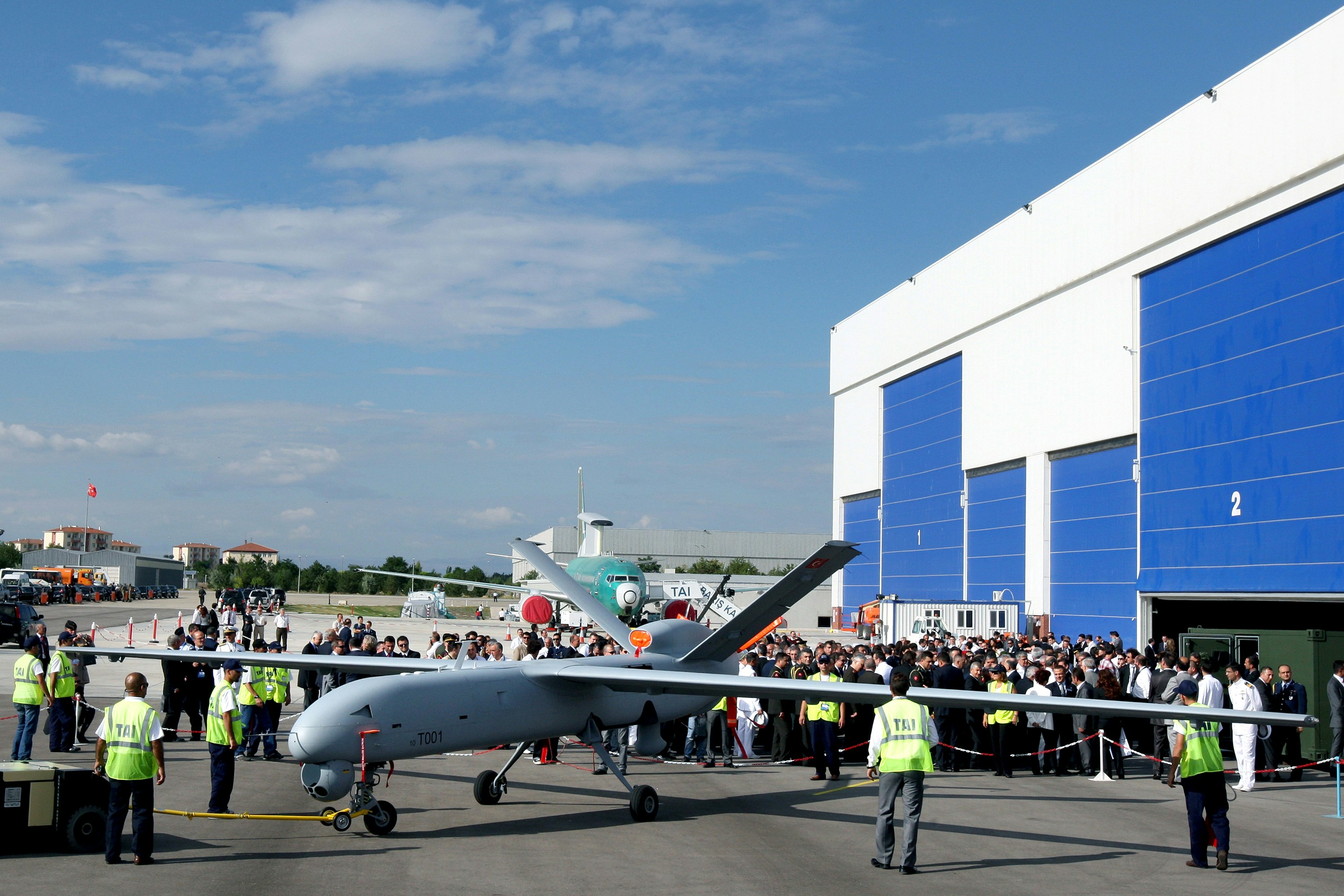
Turkey’s Anka drone showcased during a ceremony at Turkish Aerospace Space Industries Inc., near Ankara on July 16, 2010.
Photo: Burhan Ozbilici/AP
In 2010, Turkey and Israel cut off diplomatic relations altogether after an Israeli raid killed nine Turkish nationals attempting to sail a boat to the Gaza Strip. Later that year, Turkey unveiled what it claimed would be an indigenous drone to replace the Heron. The Anka, or Phoenix , developed by TAI, had a 56-foot wingspan and could stay aloft for 24 hours at nearly 10,000 meters, but like the Heron, it was not armed. That meant a critical link was still missing in the “kill chain,” said Ozcelik.
In 2011, for instance, hundreds of PKK fighters launched simultaneous attacks on Turkish bases in the southeastern province of Hakkari. Heron drones provided live footage from above, a front-row seat to the deadliest attack by the PKK in decades. “During those attacks the Herons just gave Turkey footage, and there were no response or rapid reaction abilities that were combined with the Heron systems,” Ozcelik said. Turkey went on to scramble thousands of troops in response, launching operations across the border in Iraq.
At the time, Turkey was also being provided footage and signals intelligence from the U.S., including from a handful of Predator drones piloted by the U.S. But Washington, citing concerns its NATO ally could pose a security problem for Israel, refused to sell Turkey armed drones. By 2016, Turkey had shifted away from reliance on its longtime yet unreliable ally and thought of itself in an arms race with Washington and other NATO countries. Developing its own killer drone became a top priority — and this provided an opportunity for Bayraktar.
Just a few years earlier, Bayraktar was not even able to obtain permission from the military to test his drones using live ammunition. Turkey’s military brass — promoted often not on merit but on demonstrations of their disdain for Islamic practices — were notoriously distrustful when it came to families like the Bayraktars who were devout Muslims.
But the young engineer, whose outspoken criticism of Turkey’s reliance on Israel was making him a celebrity, was gaining traction with the right people. In 2006, Bayraktar’s entry won a competition by the Turkish military for an unmanned mini drone, and Ankara ordered 19 of them to be deployed in the country’s southeast.
The Bayraktars worked the lower ranks of the military, convincing soldiers to let them embed with them in the field, where they could take detailed notes on what kind of technology was needed there. The work paid off in 2015, when they conducted a remarkable demonstration of their most advanced drone, the TB2, that caught the attention of Turkey’s military.
From an altitude of 4 kilometers, the drone hit a target 8 kilometers away using a Turkish-made guided rocket. That same year, Bayraktar made inroads in a different way — he married the youngest daughter of President Recep Tayyip Erdogan. Since then, his company has become the preferred drone manufacturer for Turkey.

Sumeyye Erdogan, left, and Selcuk Bayraktar wave during their wedding ceremony in Istanbul on May 14, 2016.
Photo: Stringer/AFP/Getty Images
The TB2 now forms the backbone of Ankara’s aerial operations. It can fly at an altitude of 24,000 feet for up to 24 hours but relies on ground control stations for communication. With a range of up to 150 kilometers, it can carry a payload of 120 pounds. The more than 75 TB2s used by Turkish forces today fly a total of about 6,000 hours a month and have become a game changer for Turkey’s counter-PKK campaign in the southeast. PKK members are no longer able to move in large groups as they did in 2011.
“For Turkey, the technical armed drones are the most important thing allowing Turkish supremacy in its operations against terrorists,” Özçelik said. “It’s all revolving around the technical armed drones.”
The video of that first demonstration Bayraktar gave in Turkey has since gone viral, and the man himself has turned into a national celebrity, a drone hero.
“You Can’t Surrender to a Drone”
In America, the debate about killer drones is generally limited to the killer drones in America’s arsenal. But thanks to the proliferation of American technology, and with little awareness outside its borders, Turkey is now among the most prolific users of these weapons.
Turkey’s drones are a near constant presence in the skies in the country’s southeast. Nearly every day, a Turkish drone, usually a TB2, either fires on a target or provides the location of a target that is subsequently bombed by an F-16 or attack helicopter. Over the last two years, as Turkish forces have pursued the PKK into northern Syria and Iraq, the drones have allowed Ankara to eliminate members of the outlawed group from the air, earning the adoration of a nation riding a wave of patriotism.
According to official sources, Turkish TB2s carrying Turkish-made guided bombs killed 449 people in northwestern Syria between January and April 2018. Scores of others have been killed in northern Iraq, including PKK leaders Ankara has been pursuing for decades. And inside Turkey, in the Kurdish-majority southeast, at least 400 people have been killed in airstrikes involving drones since 2016.
These attacks have proved powerfully popular inside the country, turning the drones into a strange sort of cultural icon. A handful of the sleek TB2 drones, with an inverted tail set back behind a propeller-driven engine, have even been autographed by President Erdogan himself. Governors in Turkey’s insurgency-plagued southeast pay regular visits to hangars housing the drones to deliver praise and pray for the welfare of the units operating them.

Turkish President Recep Tayyip Erdogan signs a drone at a military airbase in Batman, Turkey, on Feb. 3, 2018.
Photo: Murat Cetinmuhurdar, Pool via AP
But Turkey’s embrace of killing from afar has the same human rights implications that Washington’s drone campaign began raising more than a decade ago. There is evidence that some of those killed by Turkey’s drones are civilians. But with the country swept up in a nationalist fervor, the task of identifying who should be targeted by drone strikes has been delegated to a government with a broad mandate to do whatever it takes to eliminate terror groups — and little apparent attention to the fatal mistakes it seems to have made.
“You can’t surrender to an armed drone,” noted Chris Woods of Airwars. “You can’t be arrested by an armed drone. There is only one outcome when weapons engage, and that is lethal force. … And that is a great concern, particularly when armed drones are used domestically.”
The Turkish government has not been shy about publicizing the drone killings it is proud of.
One of its most dramatic attacks occurred on August 15, 2018. On that day, Ismail Ozden, a Turkish national allegedly in charge of PKK operations in Sinjar, northern Iraq, was attending a memorial ceremony near the village of Kocho. (Ozden also appeared on Turkey’s “red list” of most-wanted individuals.) As he left the memorial ceremony, Turkish intelligence was monitoring his entourage’s satellite phones and was able to learn that he was traveling in a white pickup truck as part of a PKK convoy.
The Turkish government has released an extraordinary video of the attack. A TB2 watched overhead, tracking his convoy, as one laser-guided bomb struck his pickup truck. The drone kept watching as dozens of Ozden’s colleagues streamed onto the roadway and moved him into another vehicle. As the second vehicle made its way down the road towards a fortified PKK base, the drone struck, killing Ozden and 10 others. For days afterwards, Turkish news channels and newspapers ran headlines praising the drone-led operation.
In just one offensive — against Kurdish targets in the Syrian province of Afrin in 2018 — TB2 drones were involved in nearly a fifth of the total kills Turkey claimed, directly killing 449 individuals and providing targeting for 680 others over a three-month period. A TB2 was even used to destroy a gigantic portrait of the PKK’s founder Abdullah Ocalan on a mountainside in Syria. (The government also released video of this attack.) After human rights groups claimed Turkish airstrikes had hit a hospital in Afrin, Turkey released drone footage showing it was only partially damaged.
The Afrin attacks became so famous that today you can even play a smartphone game made by Turkish university students where you pilot an armed drone in Afrin. “These combat and non-combat unmanned vehicles altered the fate of the Afrin operation and gave Turkey the upper hand,” then-Prime Minister Binali Yildirim said.
Yet when it comes to who the drones are killing, not every operation is as transparent as the one that eliminated Ozden in northern Iraq.
Killing Civilians
Last fall, Tahir Temel and his family had to leave their home in Hakkari province and move to the city of Van. Roads leading to their village of Ogul, nestled amid mountain streams about 12 miles from the Iraqi border, were marked by checkpoints, and Temel says 23 of the 25 families living there decided to leave it for good rather than face daily questioning from soldiers.
Trouble began on August 31, 2017, on the Eid al-Adha holiday, after a drone strike killed Temel’s brother and injured three relatives.
“Our mother lives in the village, so my brother went there for Eid, with three other men. They went there to pick her up and bring her to the town, but it was getting late, so they decided to stay there and have a picnic,” Temel told The Intercept. Tahir’s brother, 35-year-old Mehmet, father of two daughters and one son, earned a living as a construction worker, usually installing heating systems in buildings. The week before, he had been helping construct a hospital in the nearby city of Hakkari.

Mehmet Temel.
Photo: Courtesy of Tahir Temel
According to Tahir Temel and an investigation by lawyers from the provincial Bar Association, Mehmet Temel joined three other men from the village — Ismail Aydin, 43; Ibrahim Sak, 54; and Musa Tarhan, 54 — and drove to Ogul. As they left Hakkari, they passed through a checkpoint where their IDs were examined by police. At a spot around 300 meters from their home, under the shade of a large walnut tree, they began setting up for a barbecue. Temel and Aydin made a trip to the village to buy vegetables, returning to park their car under the walnut tree.
Two of the survivors, Tarhan and Sak, later told a delegation of human rights lawyers that around 10 minutes after the men returned from the village, a grey Mitsubishi pickup arrived on the scene. Four armed people emerged, who the survivors suspected were members of the PKK, and one briefly questioned Mehmet Temel, asking what they were doing there and what tribe he belonged to. Then, just as the strangers began heading for their pickup truck and one turned around to get a jacket he had left near the barbecue area, a drone struck them with a bomb. Sak told the lawyers he remembered dust covering everything, and Temel and two of the strangers lying motionless. Fearing a second explosion, Sak and Tarhan flagged down a car from the village and headed for a hospital in town.
“That’s how I learned about my brother, that he had been badly wounded and was still at the site of the explosion,” Tahir Temel said. “We tried to bring a car to them to rescue them, but by then there were soldiers all over the roads, and we couldn’t reach them.”
Back at the hospital, a crowd gathered, and soldiers and police kept them outside, firing tear gas to disperse them. “They did not even allow us to wash his body, to have a funeral for my brother,” Temel said. “They were just having a picnic, they were so close to their own home. They passed through a checkpoint to get there, it’s not an easy checkpoint, the police there look at your IDs, and that area was not some kind of prohibited area. We still don’t have an explanation for why the drone attacked.”
In the coming weeks, the incident became a national controversy. The day after the strike, the provincial government said 4 PKK members had been “neutralized” by a Bayraktar drone, and four “collaborators found with local terrorists” – named as Ibrahim Sak, Musa Tarhan, Mehmet Temel, and Ismail Aydin — had been injured. One of those “collaborators,” Mehmet Temel, later died of his wounds, the provincial government said. The interior ministry released a statement of its own that said four terrorists had been neutralized, naming them as Abdullah Sonmez (codenamed Piro Amed), Mordem, Zagros, and Cemal. The PKK, which occasionally announces its “martyrs,” later released a statement saying an “Abdullah Sonmez” with a codename “Piro Amed” was killed on August 31, 2017, in Hakkari.
On September 8, Ibrahim Sak and Musa Tarhan were arrested from the hospital, charged, and later convicted of being members of the PKK. Ismail Aydin, the third survivor, is also currently under detention, facing terror charges.
In Ankara, Sezgin Tanrikulu, a lawmaker from the opposition People’s Republican Party (CHP in Turkish) held a press conference holding pictures of Mehmet Temel with his children, insisting the four men were civilians, and if they were suspected terrorists, they should have been stopped at the checkpoint they passed through. “This is something only used in a war,” Tanrikulu said. “Such practices do not exist in a state of law, but only in war, and even a war has certain rules.”
President Erdogan fired back, telling reporters “a representative from the main opposition party comes forward and criticizes armed drones. He says, they shoot civilians. Where are these civilians then? The armed drones shoot terrorists. … Our armed forces will continue its fight against terrorist organizations. CHP representatives cannot stop this.”
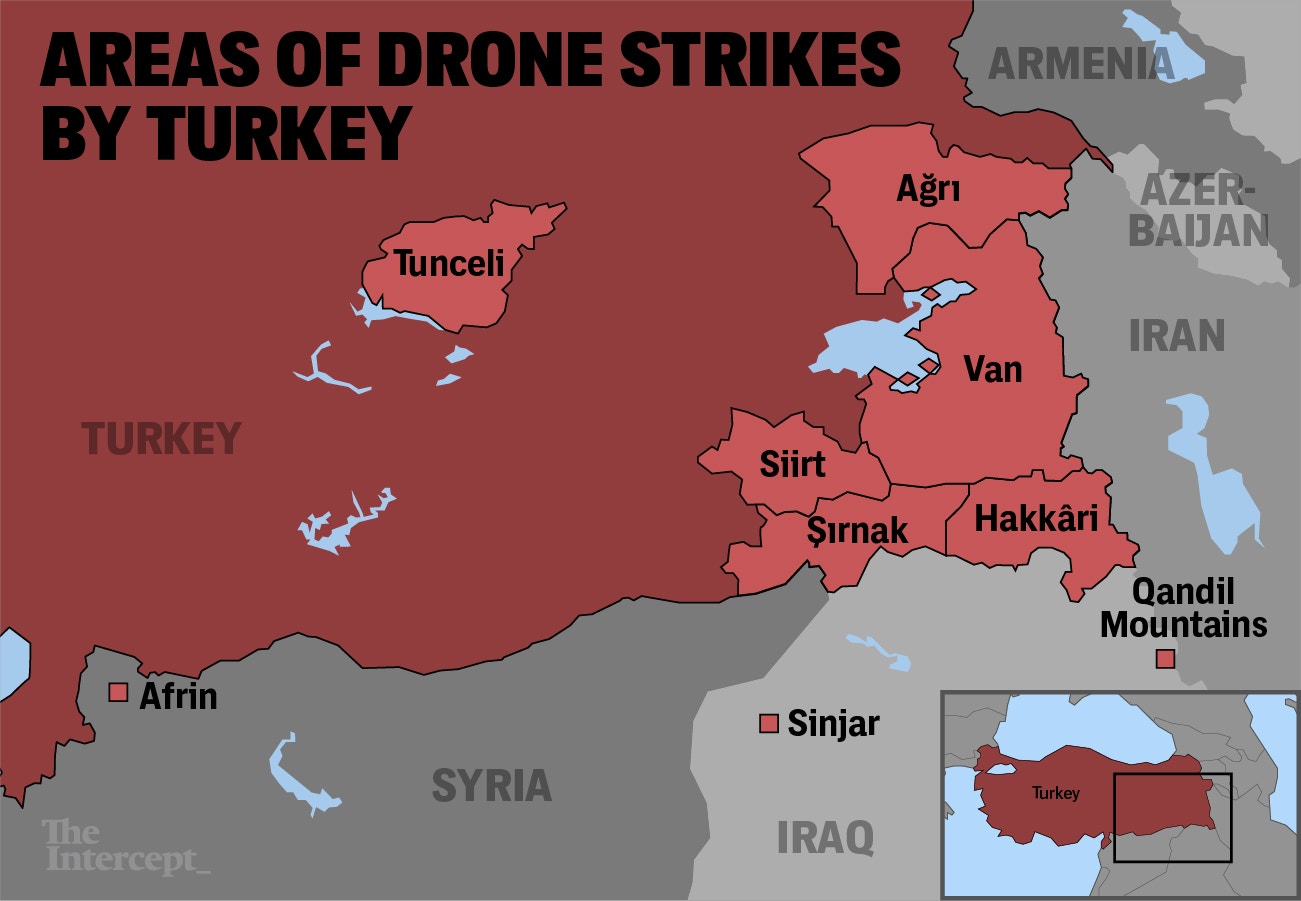
Map: Soohee Cho/The Intercept
Talking about who the drones are killing in Turkey is not easy. Criticism is seen by many in Turkey as not only siding with the PKK but also as a betrayal of a source of pride for the country. Tanrikulu, the opposition lawmaker who is outspoken on a number of human rights issues in Turkey, was threatened with an investigation from prosecutors after his statements about the Hakkari strike.
“It’s too difficult now to talk about armed drones, because of all the statements made against me,” he told The Intercept.
The group of lawyers who visited the victims’ relatives and prepared a report are facing a case of insulting the Turkish nation — a crime in Turkey — for their documentation of the strike, along with other similar actions critical of the government. “We simply did that report because it was our duty, after we heard civilians had been hurt,” Ahmet Ozmen, the former head of the Diyarbakir Bar Association who led the delegation, told The Intercept. “I cannot add anything else to that now.”
Lawmakers from the Peoples’ Democratic Party, who have also been outspoken on the issue of civilian casualties in the past, today face a litany of lawsuits over their statements, which prosecutors have said constitute support for the PKK. Since a failed coup attempt against Erdogan in 2016, around 60,000 people have been slapped with terror charges, including hundreds of lawyers, journalists, lawmakers, and others, for their statements.
“Call them whatever you want — Predator, armed drone — under international law, the way they are being used, they need to be banned all over the world,” Ozturk Turkdogan, president of Turkey’s Human Rights Association, told The Intercept. His organization is one of the few groups in Turkey that tracks casualties from the war on the PKK. It began recording the use of armed drones in 2016, but it has a difficult time following up on reports of civilian casualties and relies on victims or their families to approach them with information.
Along with the Hakkari strike, the IHD has documented three others from 2017 that may have killed civilians. On June 13, 2017, for instance, an armed drone and attack helicopters opened fire on targets in the province of Tunceli. Six people were injured, but only two names have emerged publicly, among them Ozdal Donmez, who ran a local restaurant, and Pinar Aydin, a communications graduate student. According to the official report from provincial authorities, an armed drone opened fire on a group of six “terrorists,” injuring two, then security forces followed up with an operation that killed one male and one female “terrorist.” Donmez and Aydin were detained from their hospital beds but later released .
The official reports of these and hundreds of other strikes offer a tantalizing amount of detail that makes the program far more transparent than Washington’s — and raise a multitude of legal questions.
A report on a July 19, 2017, strike in the province of Tunceli, for instance, says “a group of members of a terrorist organization were identified and fired on by an armed unmanned aerial vehicles. … 6 members of the terrorist organization were found dead.” Then, according to the statement, a ground operation was initiated and security forces recovered the bodies, along with “1 M-16 rifle, 4 Kalashnikov rifles, 1 pistol, 200gr of C4, 5 backpacks … ”
Some districts where the strikes happen are occasionally put under curfew; these are provinces like Hakkari or Tunceli or Sirnak, where the PKK has been the most active. But Ankara has not declared a war in the southeast, leaving civilians, like Mehmet Temel and his three friends in Hakkari, to risk death from above whenever they want to picnic in their own village.
Turkey’s current counterterrorism laws, Turkdogan says, clearly only allow the use of lethal force as a last resort. If Ankara wants to use the drones legally to avoid civilian casualties, they could. “They can go and identify the people there and call on a nearby military unit, and they would go and tell them to surrender, and if they don’t, then they can open fire,” he said. “But in practice, what is being done is the drone identifies the people, and they fire on them, or send F-16s or artillery or whatever and they kill them, and this is completely against the provisions of this law.”

Bayraktar TB2 UAVs before a test flight at a military base in Hmelnitski, Ukraine, on March 20, 2019.
Photo: Press Office of the President of Ukraine/Mykola Lararenko/Handout via Getty Images
Proliferating to Nonstate Groups
There are other ways in which the second drone age manifests itself in Turkey.
The drone technology that seeped from the U.S. to Turkey is now spreading to other countries. In January, Ukrainian President Petro Poroshenko announced his country would purchase 12 TB2s, in a deal estimated at $69 million. Several other countries, including Pakistan and Qatar, have lined up to purchase Turkish drones.
But it’s not just established governments that are availing themselves of the technology to attack their foes with unmanned aircraft.
On November 10, 2018, people across Turkey were commemorating the anniversary of the death of the country’s founder, Mustafa Kemal Ataturk. In many cities, the precise time of his death, 9:05 a.m., is marked by silence, with motorists pulling over on roads, and pedestrians standing still, as if time itself has stopped. In the southeastern city of Sirnak, the memorial hour was marked by a coordinated drone attack from the PKK.
Ten off-the-shelf drones, packed with C4 explosive and nails, and guided by a pre-loaded GPS route, simultaneously headed for government and military targets in the area. CCTV cameras in the city center filmed one drone as it leisurely made its way over the heads of pedestrians, heading for the entrance to the provincial government headquarters. Seven other drones crashed, without exploding, into five different military targets nearby. Two dropped improvised bombs near border posts before crashing on the Iraqi side of the border.
While the PKK’s drones have yet to cause any human casualties, Turkish news media now regularly reports on security forces shooting them down, inside the country as well as near the border with Iraq and Syria.
“The PKK has been using armed drones for a while now, and it’s becoming more frequent, and it’s actually not surprising,” said Nick Waters, an analyst at the Bellingcat investigative group who tracks the use of drones by nonstate groups in the region. “Drones have increasingly become a prestige weapon. … [T]heir use is similar to that of states. Like when the U.S. was employing armed drone strikes, it was a projection of power, and similarly, having the ability to access this power, for the PKK say, adds to your prestige.”
The aircraft used by the PKK in the November 2018 attack were easy to acquire; you can even buy them online from Amazon. The Skywalker X8 drone, which has a range of up to 100 km, costs under $300 and can be preprogrammed to fly a route via GPS. The Talon X-UAV is smaller and cheaper, and the attackers apparently rigged it to also fly a preprogrammed route.
The PKK, in fact, is late in adopting drones for combat. Islamic State began carrying out attacks with modified commercial drones in 2016, and according to a tally by Bellingcat, carried out more than 200 drone attacks in 2017 alone. Grenades with improvised fins attached to stabilize their fall were dropped by the commercially available drones, in operations that were sometimes recorded for slick propaganda videos.
It might seem strange that a group who regularly uses suicide bombers would want to publicize its reliance on killing from afar. But it shows how the most basic human instinct, self-preservation, continues to influence warfare. Armed drones appear to eliminate a key deterrent to combat: the chance that your own people could be harmed.
The U.S. pioneered the technology and showed the world how it could be used. Others have watched and learned. Turkey won’t be the last country to manufacture its own drones, and its public will not be the last to see them as a source of pride.



